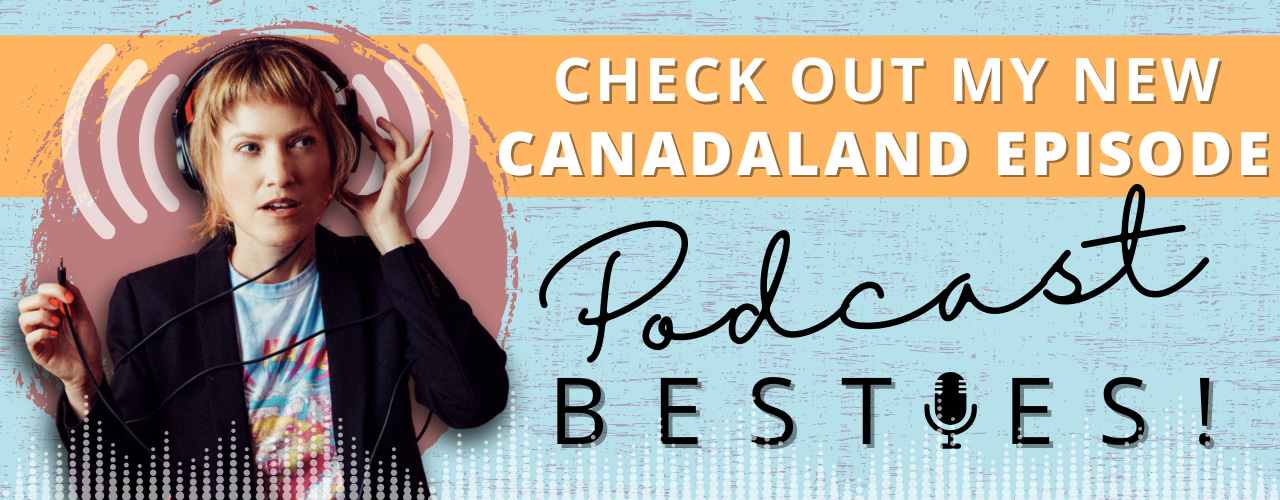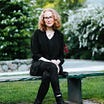The Art of Editorial Alchemy & Listening Like a Pro
Julie Shapiro reflects on her career, craft & our new story for Canadaland
Hi Besties!
has spent decades shaping the sound of modern audio storytelling from behind the scenes—her editorial fingerprints are everywhere. As a founding producer of Radiotopia, the longtime artistic director of the Third Coast International Audio Festival, and now the creative force behind the experimental short-form initiative Audio Flux, she’s played a major role in bringing some of the most iconic, boundary-pushing work in podcasting to life, including the award-winning series Ear Hustle.I was SO STOKED when I found out I’d be working with Julie on my recent story for Canadaland about my stint selling T-shirts on the Girls Gone Wild tour when I was 21. It’s a narrative nonfiction episode that weaves together my personal experience, the company’s history, and the toxic culture we were all swimming in at the time (and maybe still are?). It’s about pop culture, power dynamics, complicity, sex positivity—and the insights I’ve gained with time. And it dropped this week!
🎧 Listen here: #1160 Confessions of a Girls Gone Wild Merch Girl
In this Q&A, Julie shares what it was like to collaborate on this story, highlights from her decades in audio, her editorial philosophy and creative process, and advice for emerging editors—plus the lessons she’s still learning from sound.
Looking back at your time with Radiotopia, the ABC’s Creative Audio Unit, and Third Coast—what are some of the proudest moments of your impressive career in audio?
JS: So many moments build on each other, and blend together (it’s all connected!) but a few things do stand out:
In my first radio job, producing a call-in talk show about seminal literature from the coastal southeast, I convinced Charles Frazier, who was famously NOT into being interviewed, to join us for a conversation about Cold Mountain.
Laying the groundwork for so many international relationships and connections during my time with the Third Coast Festival, as this really stretched ears and imaginations (including mine) by introducing so much audio and so many audio makers from far beyond North America.
Helping start the Ear Hustle podcast while I was Executive Producer with Radiotopia, and working closely with that amazing team for six-plus years, was no doubt the most impactful professional and personal experience I’ve had in audio. It changed my relationship to audio, and to the power of creative collaboration, and I remain very, very proud of all that we accomplished, and that they continue to.
Starting Audio Flux! More on that later.
You’ve shaped some of the most iconic shows and stories in podcasting. What do you think makes a great editor? What do you consider your editorial superpower?
JS: Every situation is different, but for me, these skills are crucial to successful creative partnerships, as an editor:
Getting to know a team and understanding how they work best—systems, workflow, even down to font choice on scripts—it’s imperative to make sure we’re all speaking the same language about the process.
Balancing the macro and the micro observations and feedback—constantly holding the big picture (story arc) and smallest details (tense consistency) at the same time.
Pushing stories into their own unique places, and helping hosts/producers to find their authentic selves in their scripts and delivery.
Always, always thinking about how sound can help tell and shape a story or moment.
When you’ve come into a project—like Ear Hustle or more recently The Copernic Affair—what’s your process for understanding what a show wants to be? How do you help steer it there?
JS: Every collaboration starts with listening. I listen to the producers, and ask a lot of questions about what is driving them to tell whatever story I’m helping them tell, and how they envision it all coming together. For me editing or Executive Producing comes with wearing many hats, and going with flows, negotiating the other forces exerted, inevitably, on every project. But I’m basically there to help them tell their story, or build their show.
To that end, the listening is not only helpful, but constant. To producers, to tape, to the sound design. To the story itself—understanding a narrative from the inside out is only achieved through all of this listening.
For new or emerging editors who want to build a career like yours, what skills should they focus on first?
JS:
Again, listen! In this case, listen to as much audio (besides the projects you are also working on) as you can get your ears on, which will help you become fluent in different production styles and aspirations.
Initiate conversations about craft and style, to help you articulate your opinion and feedback.
Let each different project be its own, original thing. Understand the inner workings of your team and the shape of the story they are trying to tell in each particular situation.
Put yourself in a listener’s perspective often, so you’re constantly thinking about how the project you’re editing will be absorbed.
You worked with me on this Girls Gone Wild episode for CANADALAND. What did you find exciting about this story?
JS: From the start I was compelled by the energy and provocation of your experience. By your desire to understand your younger self, by your interest in defining something that you had not yet figured out, but wanted to. That this wasn’t necessarily the story anyone might expect, at the start. I’m very drawn to stories told “from the inside” and so your personal connection to the history of this crazy company felt unusual, and more interesting than a story pitched by someone completely from the outside.
What were some of the editorial challenges or breakthroughs we experienced?
JS: A few challenges were… defining something for yourself, that you had not yet figured out! And finding a system-groove and rhythm for script edits, and notations—but we got there. Trimming back characters and storylines is always challenging, but I felt that once we did, we could focus more on your perspective and experience. We definitely struggled to land on an ending that felt appropriate—not too “inspirational” or “rah-rah” or like a rallying cry—but something that would convey the seriousness of the story, and the reality you’re telling it in right now. We also thought a lot about how to format and design the story so it would feel right for Canadaland, in tone and approach. I personally am used to having access to the sound designer on a project, so it was a little bit of adjustment for me that this wasn’t the case with this episode.
[Editor’s note: I’m so locked in with that I brought him on to do the early mixing and sound design, which was definitely my preference, and I think he crushed it. No regrets! But I didn’t think about how that would affect Julie’s usual process.]
What did this project teach you—about editorial judgment, story structure, working with others, etc.?
JS: Every project teaches something. For your GGW story, I thought a lot about how to balance the documentary elements with the personal, and how to help you emerge as your true self. And I definitely learned more about Girls Gone Wild than I ever imagined I’d know… which has turned out to be useful in a conversation more often than one might think. (Though maybe not, after listening to the episode.)
You’ve held a wide range of roles across the audio world. What keeps you engaged and creatively fulfilled in this medium?
JS: I’ve always been a listener and appreciator of sound, music, art, storytelling. I feel more alive and engaged with the world when discovering new artists, producers, and shows. Podcasting has taken the medium to new places—some that feel alien to me, some in which I feel right at home. But I’m constantly astounded by what I hear, and the audio that I listen to shapes my perspectives and how I move through the world.
And at the end of the day… audio people are the best people! The relationships I’ve developed along the way (thousands by now) mean everything, and keep me invested and creatively fulfilled in both my day to day and each new chapter I find myself in.
Explain what Audio Flux is, what sparked the idea, and what kind of work you’re doing.
JS: Audio Flux! My current true audio love. It’s a new space for innovative, short-form audio and bold storytelling. We invite people to make short audio works (three minutes long) inspired by a set of creative prompts, and for each “circuit” we work with a different creative partner to design different prompts. We debut eight original pieces each time at a live event, and feature them at audioflux.org and—soon—on our upcoming podcast. It’s a very fun and joyful art and storytelling project, open to everyone and here’s the thing: It always works! It always works to invite people into your creative process.
You’ve inspired over 200 “fluxworks” already—what have been some of the standout submissions for you? Anything that totally surprised you?
JS: 231, to be exact. And it sounds like a lazy answer, but every single fluxwork brings an element of surprise. Because in each case the resulting story comes through an interpretation of concrete prompts, and no two people explore these parameters in the same way. But a few that have especially delighted, in their strangeness, or beautifulness, or message, or simply for personal reasons:
From Circuit 01: Letting Go / Grams, by Aaron Edwards
From Circuit 02: Listening With / In Between Silence, by Talia Augustidis
From Circuit 03: Pet Sounds open call: She a Good Girl Despite Some Evidence to the Contrary by Sharif Youssef
From Circuit 04: Firsts / Like Pulling Teeth, by Alan Goffinski
How can audio folks get involved with Audio Flux?
JS: Anyone and everyone is invited and encouraged to participate. We run two circuits per year, and will be announcing Circuit 06, including our creative partner, theme and prompts, on August 1st. The best way to hear all about it is to sign up for our newsletter at audioflux.org, and follow us on IG and Bluesky.
And if you’re in D.C., join us Sunday, June 1st, at 11am ET, for our debut of Circuit 05: In 3D! It’s a free, all-ages show, that’s part of the Sound Scene Festival, held at the Hirshhorn Museum. It’s going to be pretty special.
What kind of stories or collaborations are you hoping to do more of next?
JS: At the moment I’m open to new projects and collaborations, as long as the people I’m working with are passionate about the work, and are ambitious and responsive. I like cultural explorations, and smart conversations. I’m making some plans to take Audio Flux into classroom environments and work with students or creators at all levels—AF is such an excellent and obvious tool for learning about production, critical listening, and the creative process writ large. And for reminding producers that audio can be joyful! Which often gets left out of the professional equation.
Thanks, Julie! It was such an honor to work with you. I had a blast and learned a bunch. 🙌💙
➡️ Sign up for the Audio Flux newsletter at audioflux.org.
➡️ Follow Julie on Instagram @jatomic and Bluesky @jatomic.bsky.social.
➡️ Listen to Canadaland episode #1160 Confessions of a Girls Gone Wild Merch Girl.
I’m teaching some upcoming workshops you might be interested in:
How to Build a “Platform” for Writers Who Shudder at the Thought
Podcasting for Writers: How to Start, Sustain & Grow Your Podcast
Start a Newsletter to Supercharge Your Platform, Network and Business
So… ROLL CALL! 🗣
What’s YOUR editorial superpower—and what’s one area you’d like to improve?







